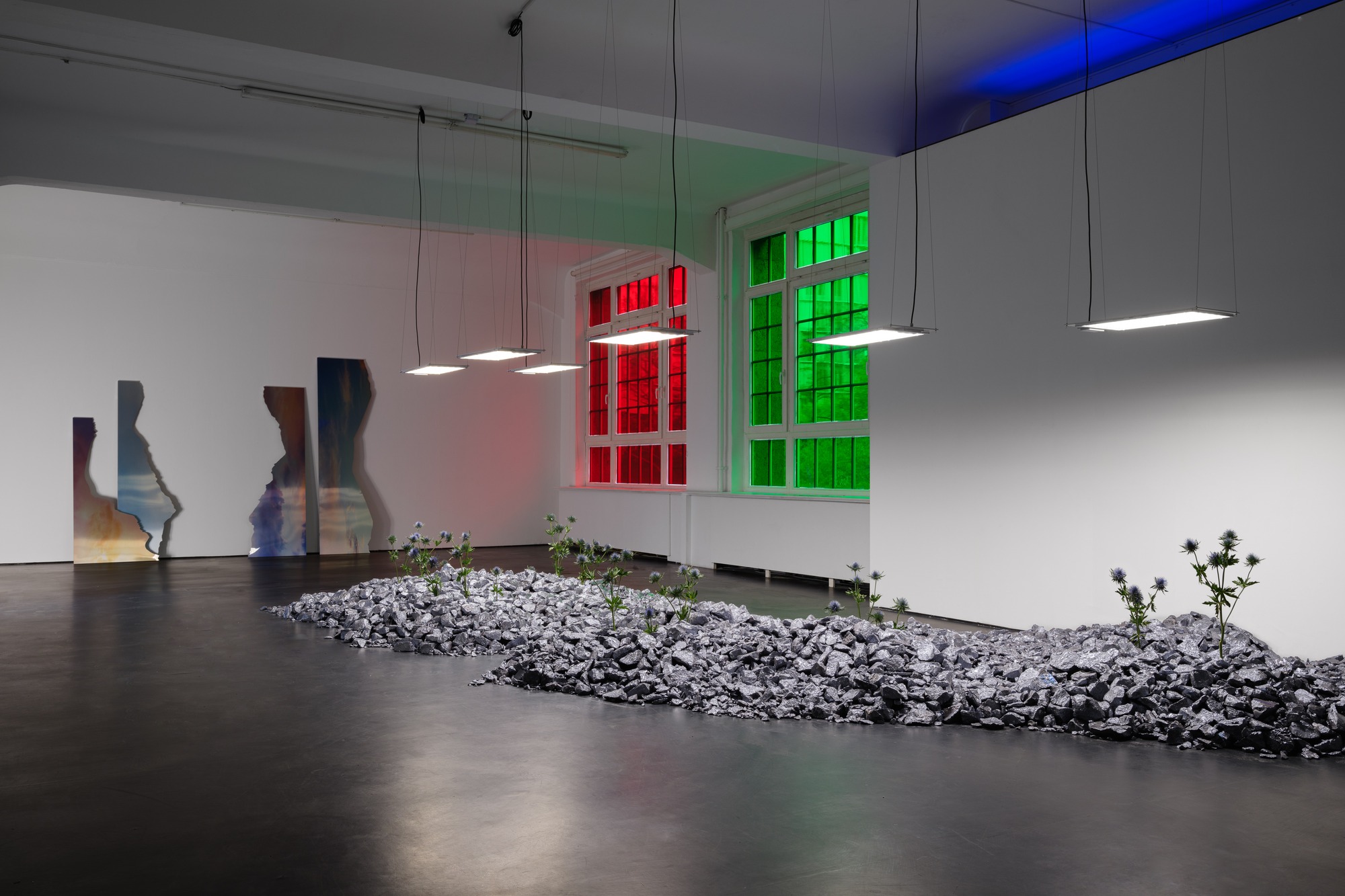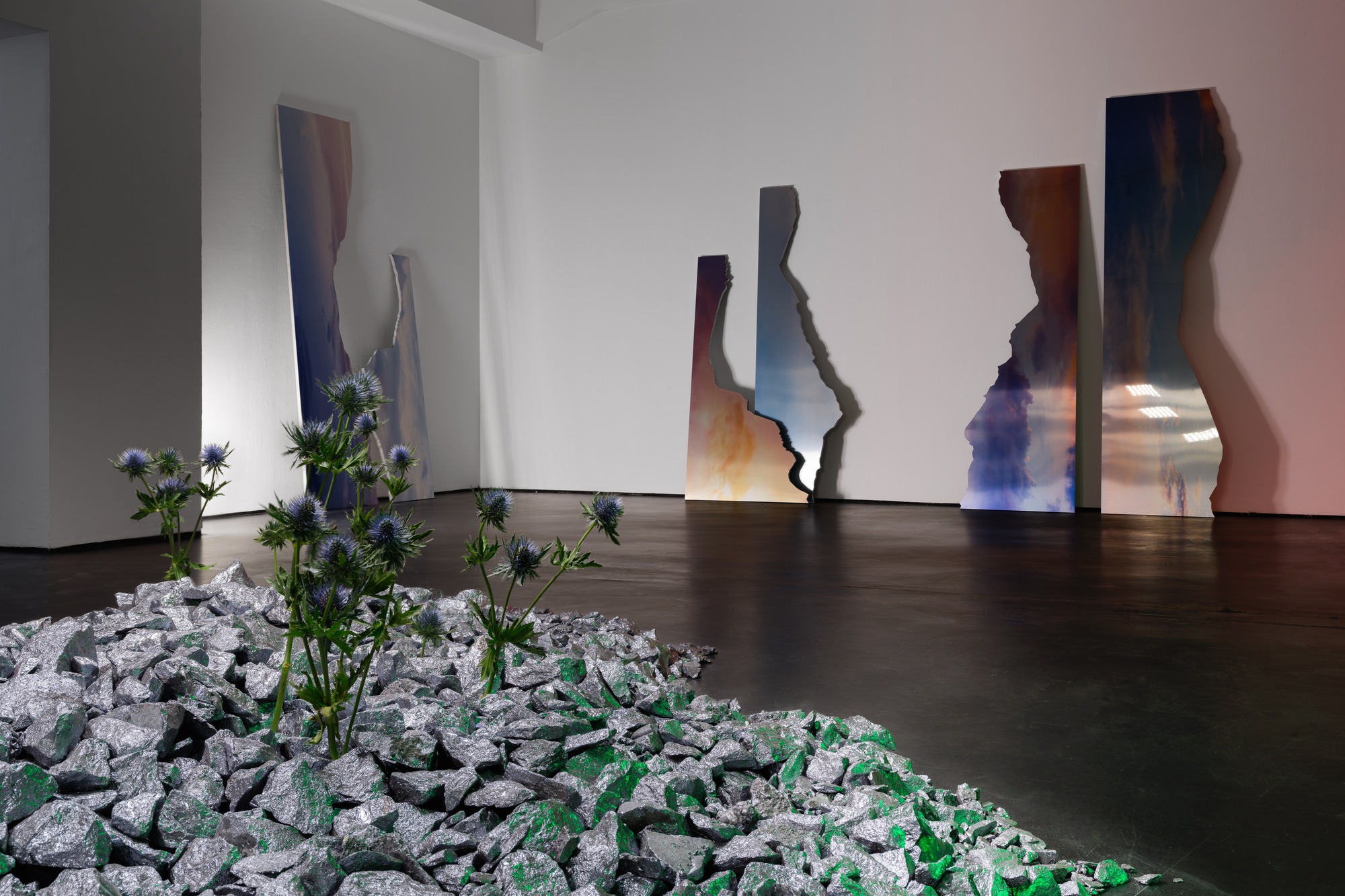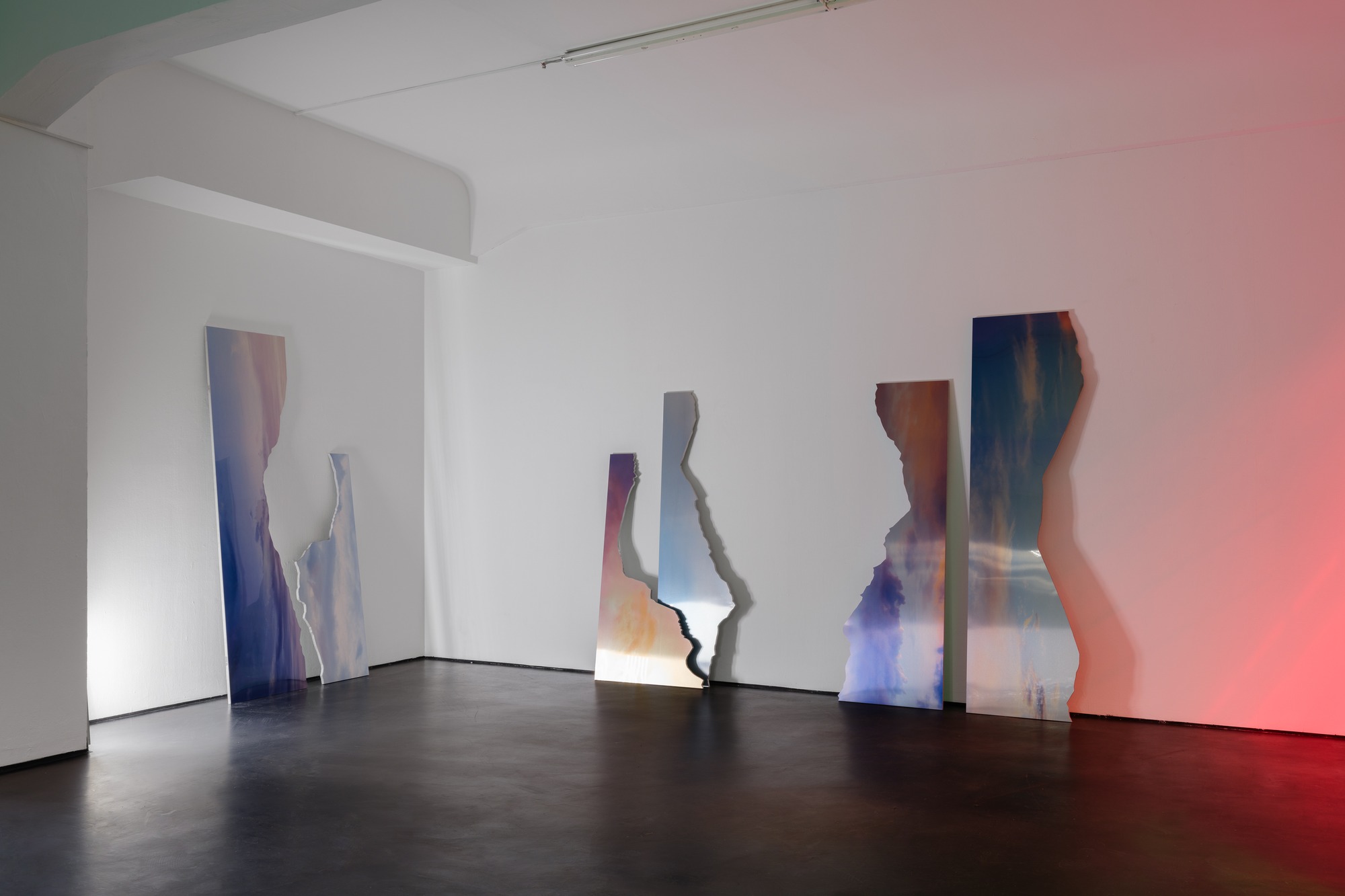Troika | anima atman
26 Apr - 22 Jun 2024

Installation view Troika, anima atman, 2024
Courtesy of max goelitz
Copyright of the artists
Photo: Marjorie Brunet Plaza
Courtesy of max goelitz
Copyright of the artists
Photo: Marjorie Brunet Plaza

Installation view Troika, anima atman, 2024
Courtesy of max goelitz
Copyright of the artists
Photo: Marjorie Brunet Plaza
Courtesy of max goelitz
Copyright of the artists
Photo: Marjorie Brunet Plaza

Installation view Troika, anima atman, 2024
Courtesy of max goelitz
Copyright of the artists
Photo: Marjorie Brunet Plaza
Courtesy of max goelitz
Copyright of the artists
Photo: Marjorie Brunet Plaza

Troika
Anima Atman, 2024
Courtesy of max goelitz
Copyright of the artists
Photo: Marjorie Brunet Plaza
Anima Atman, 2024
Courtesy of max goelitz
Copyright of the artists
Photo: Marjorie Brunet Plaza

Installation view, Troika, Obsolete Landscapes, 2024
Courtesy of max goelitz
Copyright of the artists
Photo: Marjorie Brunet Plaza
Courtesy of max goelitz
Copyright of the artists
Photo: Marjorie Brunet Plaza

Troika
Evolutionary Composite, 2023
Courtesy of max goelitz
Copyright of the artists
Photo: Marjorie Brunet Plaza
Evolutionary Composite, 2023
Courtesy of max goelitz
Copyright of the artists
Photo: Marjorie Brunet Plaza

Troika
Irma Watched Over by Machines, 2021
Courtesy of max goelitz
Copyright of the artists
Photo: Dirk Tacke
Irma Watched Over by Machines, 2021
Courtesy of max goelitz
Copyright of the artists
Photo: Dirk Tacke
max goelitz is pleased to present Troika’s first solo show in Germany. In their exhibition anima atman, the London–based art group continues their interest in the intersections between virtual and material realities in new installations, paintings, and sculptural objects. (1)
In the eponymous central installation, Troika experiments with the assumption that plants have intelligent behavior and independent consciousness. A group of thistles grow out of an illuminated barren landscape of shimmering silicon rocks. The thistles seem to move in an uncanny way on their own, demonstrating an unusual life force. As if imbued with a supernatural or otherworldly energy the leaves and stems slowly move, giving the disconcerting impression of a slow–motion film, yet visible in reality. The installation thus evokes a situation of uncertainty, a threshold where the previously familiar world is experienced as strange and alien. In Anima Atman (2024), Troika explore other forms of non–human intelligence, existence or living systems by focusing on the agency of plant life. They raise philosophical questions about the forces that give life to matter, what constitutes intelligent life, and the role of human beliefs, knowledge and understanding.
The individual groups of works in the exhibition evoke the idea of waste land. (2) Wastelands are areas characterized by absence. They are abandoned, overgrown sites that were previously developed or inhabited by human activity. As a result of destruction or climatic conditions, they provide an environment for communities of plants, animals, and new life forms to take hold. For example, thistles are generally considered to be particularly hardy plants that can grow as invasive species in wasteland or barren desert landscapes.
The eradication of wild landscapes is reflected in Troika’s new series Obsolete Landscapes (2024), presented here for the first time. The series pictures sky fragments of Apple Inc.’s desktop backgrounds from which all landscapes have been erased. With an aesthetic echoing romanticized depictions of landscape photography the desktop backgrounds have rapidly transformed California’s natural landmarks into a picture of banality. Beginning with Yosemite (10.10.5) and El Capitan (10.11.6), the naming convention of Apple Inc.’s operating systems expanded from the titles of individual summits to entire mountain ranges such as Sierra (10.12.6) and High Sierra (10.13.6). The Mojave Desert (10.14.6) followed suit, as did Santa Catalina Island (10.15.7). While this trend cannot persist indefinitely, the series points to technological advancement and its contribution to the history of landscape erosion – both in terms of resource extraction for the making of its products, and by making natural sites obsolete with each new update. Nature is reduced to a digital facsimile.
In their wall works Evolutionary Composite (2023), Troika focus on salt crystals as the driving force behind a series of inventions and technologies that have significantly shaped human civilization. In the series, Troika combines one of mankind‘s oldest tools – a flint hand axe – with a silicon wafer used in the manufacturing of computers. Flint tools, such as axes, were crafted from a fine–grained quartz known as cryptocrystalline rock (salt in the guise of a stone) and were among humanity’s earliest and mass–produced technologies. Millenia later, a chemical compound found in flint resurfaces in the form of silicon – the foundational material of modern computer technology. Both objects bookend the human quest for technological prowess.
For new works in their series Irma Watched Over by Machines (2021), Troika appropriated images from surveillance cameras taken during the Hurricane Irma in 2017. They transfer the original RGB color spectrum of the digital image sensors into complex painterly compositions that develop an ambiguity between the objectification of the devastating event through the neutral, technical recording and the emotional content of the image.
Troika is a contemporary art group founded in 2003 by Eva Rucki (*1976, Germany), Conny Freyer (*1976, Germany), and Sebastien Noel (*1977, France). The artists live and work in London, UK. The collective’s paintings, sculptures, films, and large–scale installations contemplate on the intersections between analog and digital realities. At the center of their interest are humanity‘s experiences and knowledge gained through technology and how these transform our under- standing and relationships to nature, society, and reality. Troika’s collaborative approach is usually based on in–depth scientific research in the fields of natural philosophy and the history of technology. Their work incorporates complex questions about artificial intelligence, algorithmic data, alternative forms of life, and virtual and physical representation systems.
Troika‘s works are currently part of the group exhibition Poetics of Encryption at KW in Berlin. In addition to the solo exhibition at max goelitz in Berlin, Troika will present solo exhibitions this year at the MAK in Vienna and at the Langen Foundation in Neuss. Selected recent solo exhibitions have been shown at Espacio Arte Abierto in Mexico City (2021), Barbican Gallery in London (2018), NC–arte in Bogotá (2015) and Daelim Museum in Seoul (2014).
(1) Anima (lat.) means breath or soul; Ātman (Sanskrit, term from Indian philosophy) has a similar meaning, whereby this can include the essence of every existence, including the soul of animals or plants.
(2) The term refers to one of the most famous poems of the 20th century by T.S. Eliot „The Waste Land“ (1922), published in German translation by Norbert Hummelt „Das öde Land“ (2008).
In the eponymous central installation, Troika experiments with the assumption that plants have intelligent behavior and independent consciousness. A group of thistles grow out of an illuminated barren landscape of shimmering silicon rocks. The thistles seem to move in an uncanny way on their own, demonstrating an unusual life force. As if imbued with a supernatural or otherworldly energy the leaves and stems slowly move, giving the disconcerting impression of a slow–motion film, yet visible in reality. The installation thus evokes a situation of uncertainty, a threshold where the previously familiar world is experienced as strange and alien. In Anima Atman (2024), Troika explore other forms of non–human intelligence, existence or living systems by focusing on the agency of plant life. They raise philosophical questions about the forces that give life to matter, what constitutes intelligent life, and the role of human beliefs, knowledge and understanding.
The individual groups of works in the exhibition evoke the idea of waste land. (2) Wastelands are areas characterized by absence. They are abandoned, overgrown sites that were previously developed or inhabited by human activity. As a result of destruction or climatic conditions, they provide an environment for communities of plants, animals, and new life forms to take hold. For example, thistles are generally considered to be particularly hardy plants that can grow as invasive species in wasteland or barren desert landscapes.
The eradication of wild landscapes is reflected in Troika’s new series Obsolete Landscapes (2024), presented here for the first time. The series pictures sky fragments of Apple Inc.’s desktop backgrounds from which all landscapes have been erased. With an aesthetic echoing romanticized depictions of landscape photography the desktop backgrounds have rapidly transformed California’s natural landmarks into a picture of banality. Beginning with Yosemite (10.10.5) and El Capitan (10.11.6), the naming convention of Apple Inc.’s operating systems expanded from the titles of individual summits to entire mountain ranges such as Sierra (10.12.6) and High Sierra (10.13.6). The Mojave Desert (10.14.6) followed suit, as did Santa Catalina Island (10.15.7). While this trend cannot persist indefinitely, the series points to technological advancement and its contribution to the history of landscape erosion – both in terms of resource extraction for the making of its products, and by making natural sites obsolete with each new update. Nature is reduced to a digital facsimile.
In their wall works Evolutionary Composite (2023), Troika focus on salt crystals as the driving force behind a series of inventions and technologies that have significantly shaped human civilization. In the series, Troika combines one of mankind‘s oldest tools – a flint hand axe – with a silicon wafer used in the manufacturing of computers. Flint tools, such as axes, were crafted from a fine–grained quartz known as cryptocrystalline rock (salt in the guise of a stone) and were among humanity’s earliest and mass–produced technologies. Millenia later, a chemical compound found in flint resurfaces in the form of silicon – the foundational material of modern computer technology. Both objects bookend the human quest for technological prowess.
For new works in their series Irma Watched Over by Machines (2021), Troika appropriated images from surveillance cameras taken during the Hurricane Irma in 2017. They transfer the original RGB color spectrum of the digital image sensors into complex painterly compositions that develop an ambiguity between the objectification of the devastating event through the neutral, technical recording and the emotional content of the image.
Troika is a contemporary art group founded in 2003 by Eva Rucki (*1976, Germany), Conny Freyer (*1976, Germany), and Sebastien Noel (*1977, France). The artists live and work in London, UK. The collective’s paintings, sculptures, films, and large–scale installations contemplate on the intersections between analog and digital realities. At the center of their interest are humanity‘s experiences and knowledge gained through technology and how these transform our under- standing and relationships to nature, society, and reality. Troika’s collaborative approach is usually based on in–depth scientific research in the fields of natural philosophy and the history of technology. Their work incorporates complex questions about artificial intelligence, algorithmic data, alternative forms of life, and virtual and physical representation systems.
Troika‘s works are currently part of the group exhibition Poetics of Encryption at KW in Berlin. In addition to the solo exhibition at max goelitz in Berlin, Troika will present solo exhibitions this year at the MAK in Vienna and at the Langen Foundation in Neuss. Selected recent solo exhibitions have been shown at Espacio Arte Abierto in Mexico City (2021), Barbican Gallery in London (2018), NC–arte in Bogotá (2015) and Daelim Museum in Seoul (2014).
(1) Anima (lat.) means breath or soul; Ātman (Sanskrit, term from Indian philosophy) has a similar meaning, whereby this can include the essence of every existence, including the soul of animals or plants.
(2) The term refers to one of the most famous poems of the 20th century by T.S. Eliot „The Waste Land“ (1922), published in German translation by Norbert Hummelt „Das öde Land“ (2008).
